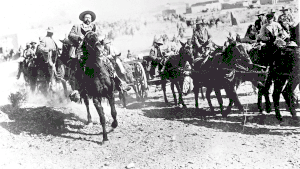Battle of Guerrero
| Battle of Guerrero | |||||||
|---|---|---|---|---|---|---|---|
| Part of the Border War, Pancho Villa Expedition, Mexican Revolution | |||||||
 Pancho Villa and his men at Ojinaga, Chihuahua in 1916. | |||||||
| |||||||
| Belligerents | |||||||
|
|
Villistas | ||||||
| Commanders and leaders | |||||||
|
|
| ||||||
| Strength | |||||||
| 370 cavalry | 200-500 cavalry[1][2] | ||||||
| Casualties and losses | |||||||
| 5 wounded |
56 killed 35 wounded | ||||||
The Battle of Guerrero, or the Battle of San Geronimo,
Battle
The Mexican Expedition began after Pancho Villa's
Much time was lost in the march and the men were exposed to
Initially the Battle of Guerrero was thought to be a great opening success in the campaign but it later proved to be a disappointment as it would be the closest they came to capturing Villa in battle. However, the battle was considered the "most successful single engagement of Pershing's Punitive Expedition." After the retreat the Villista army dispersed and for the next three months they no longer posed a significant threat to the United States military. Villa himself hid out in the hills while his knee healed. One day, not long after the battle, Villa was camped at the end of a valley and watched a troop of Pershing's cavalrymen ride by. Villa heard them singing "It's a Long Way to Tipperary," this would be the last time Americans got so close to the rebel. News of the victory was widely circulated in the United States, prompting the Senate's approval of Colonel Dodd's promotion to brigadier general.[1][2][5]
See also
- Mexican Revolution
- Mier Expedition
- Crabb Massacre
- Crawford Affair
References
- ^ a b c d e Boot, pg. 199
- ^ a b c d First World War.com - Primary Documents - General Pershing on Military Operations in Mexico, 30 March 1916
- ^ Elser, Frank B. (April 5, 1916). "FIRST FULL REPORT OF GUERRERO FIGHT; Seventh Cavalry Had Drawn No Rations for Two Weeks Before Final Dash. ENCIRCLING THE OUTLAWS Troopers of the Tenth, Eleventh, and Thirteenth Regiments Also Helped to Set Trap". The New York Times.
- ^ 2nd Battalion, 7th Cavalry Regiment
- ^ a b c Beede, pg. 218-219
Bibliography
- LCCN 2004695066.
- Beede, Benjamin R. (1994). The War of 1898, and U.S. interventions, 1898-1934: an encyclopedia. Taylor & Francis. ISBN 0-8240-5624-8.
